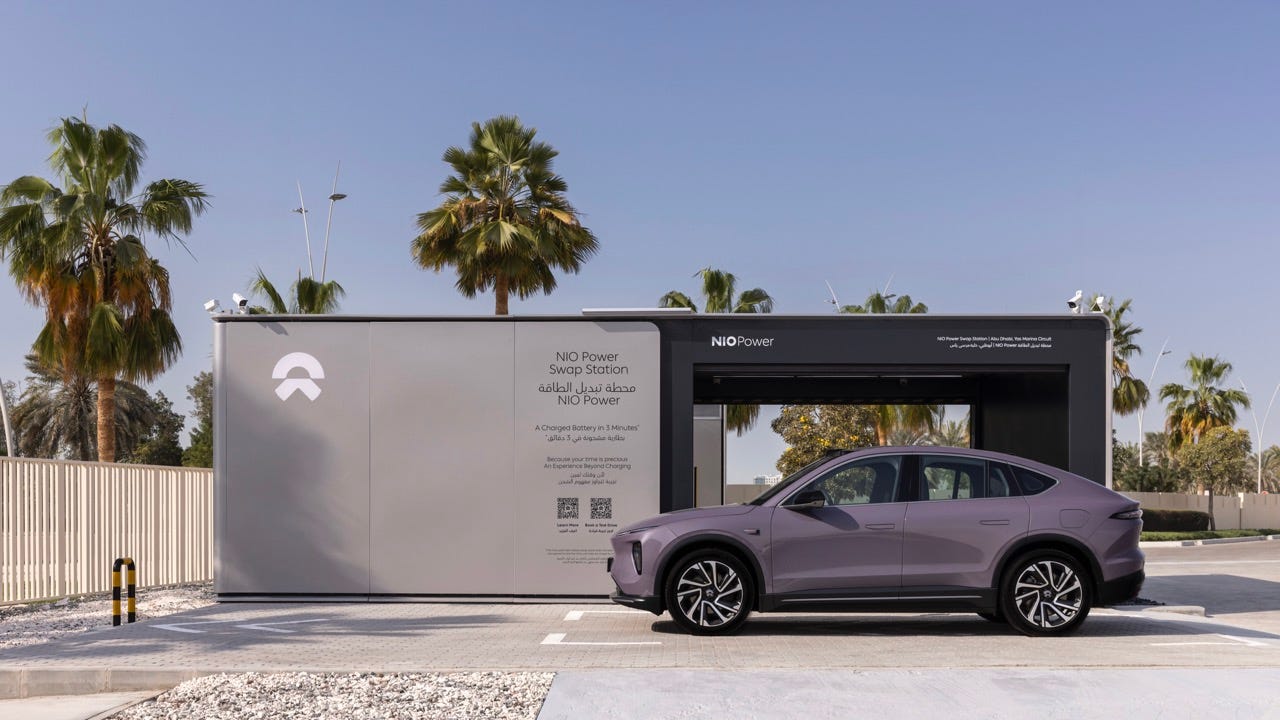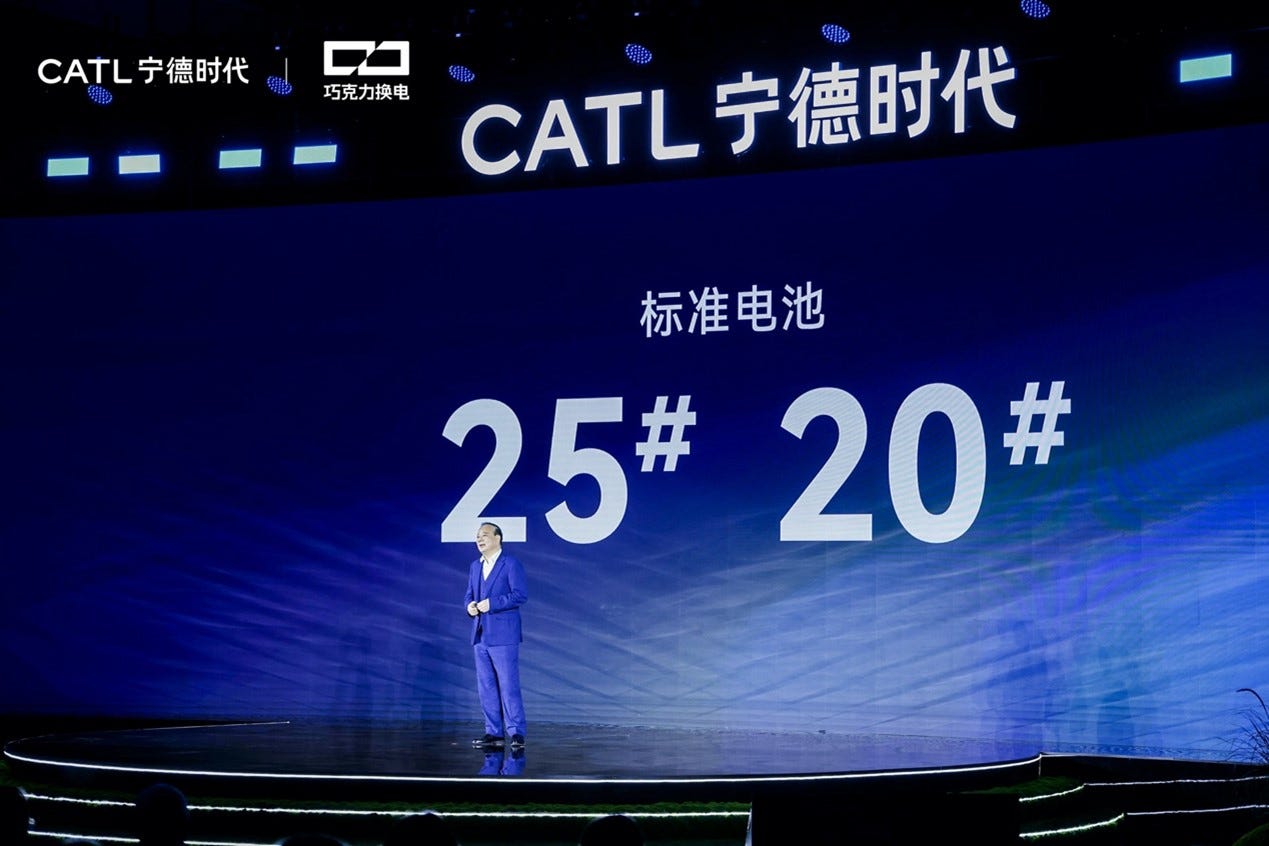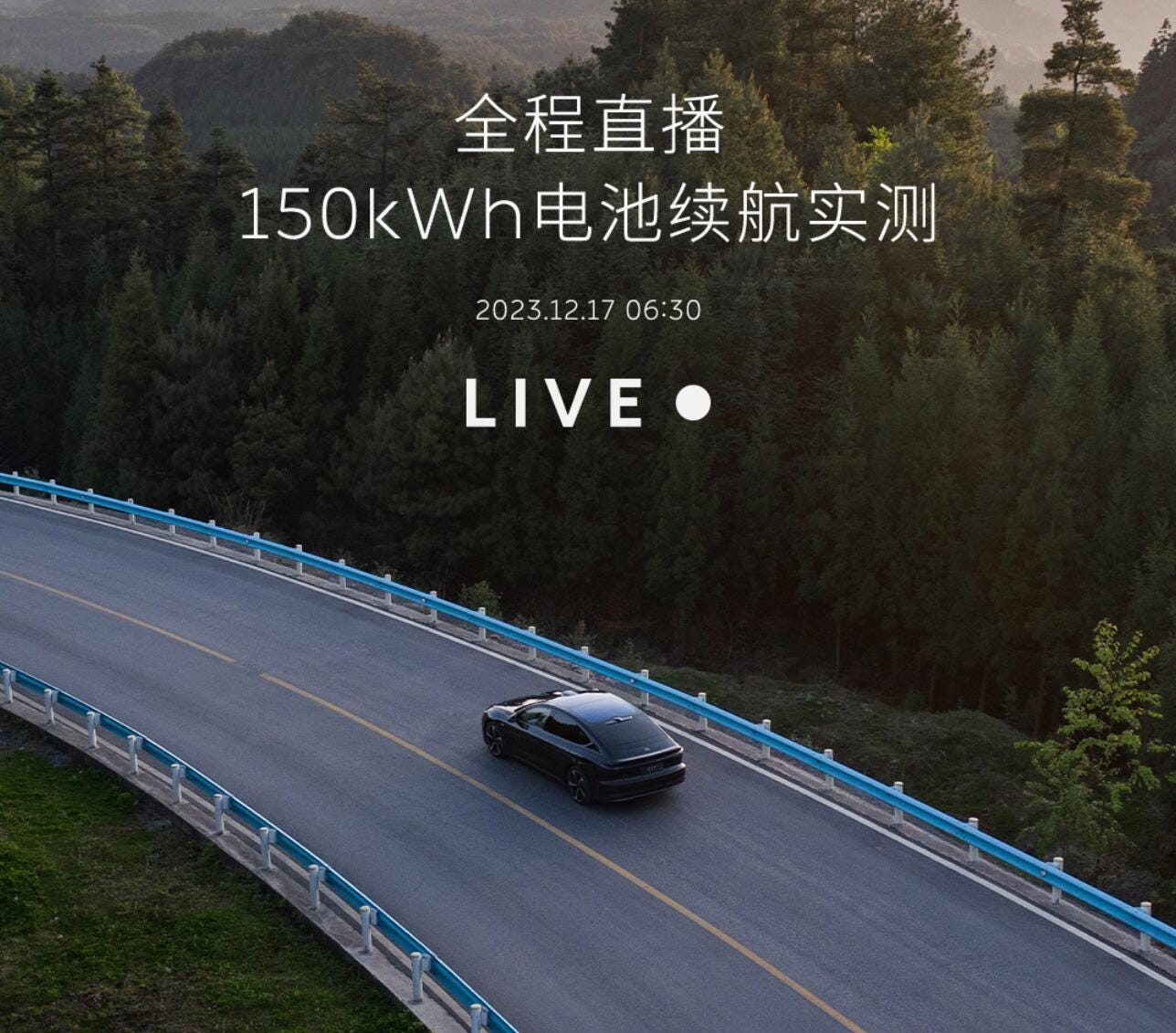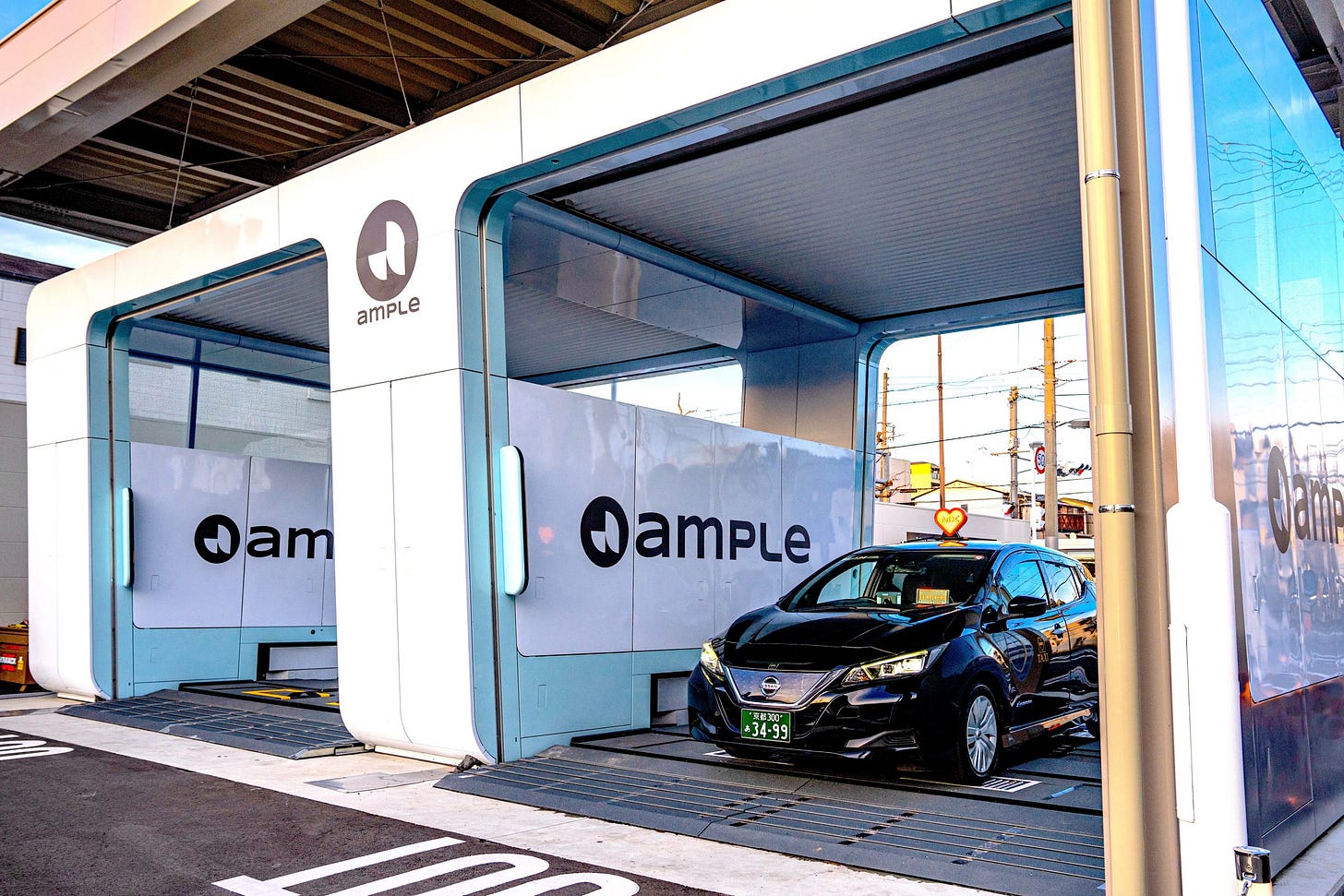On March 18, BYD announced its Super e-Platform boasting an impressive 1 megawatt charging capacity, making charging speed on par with gas refueling.
The same day, CATL and NIO announced a partnership on battery swapping, aiming to, again, making EVs as fast to refuel as ICE cars by simply swapping the empty battery with a full one.
Just a day later, on March 19, Porsche Engineering revealed its intriguing 'AC battery' concept, which can use AC current directly to recharge, without needing an inverter.
These three press releases all imply some pretty cool innovations around EV battery architecture, albeit in pretty different ways. You can read part 1 here. Today’s part 2 will focus on CATL and pack swapping.

Battery Swapping: Concept
As we saw in part 1, ultra-fast charging at powers over the MW is not without challenges. It requires high-voltage architectures for the battery pack and the power electronics, and puts a significant weight on the grid. Even in a future where the grid can handle the load, it is a technology that seems more appropriate for higher-end, high-performance vehicles.
On March 18, CATL and NIO announced a partnership to scale the pack swapping technology, aiming to make EVs as fast to “refuel” as ICE cars, but without stressing the battery or the grid, and without requiring a high-voltage architecture.
NIO’s swap stations can already complete a battery exchange in under three minutes, without the driver even getting out of the vehicle. The car is automatically positioned, the battery removed and replaced robotically, and the system handles billing through the user account.
To enable large-scale battery swapping, NIO developed vehicles with swappable packs integrated into the chassis, relying on precise mechanical alignment and automated stations. But scaling this model across the industry calls for a standardized, interoperable battery architecture that multiple automakers can adopt.
That’s where CATL steps in, with some big news coming in late 2024.
At the Choco-Swap conference in December 2024, CATL unveiled two standardized battery formats, the #20 and #25 models (which can be seen as a parallel to the #92 and #95 gasoline grades). Each comes in both LFP and NMC chemistries, with capacities ranging from 42 to 70 kWh, tailored to A0 and A/B class vehicles. These formats are designed to be swappable across multiple brands and platforms: CATL has officially signed cooperation agreements with major automakers like Changan, BAIC, GAC, Wuling, and FAW.
A few days later on the 24th of December 2024, CATL announced the Bedrock chassis, further cementing its position downstream of the battery value chain and further towards EVs. The chassis ‘supports mechanical decoupling’ (which I interpret as swap-compatible) and will be used by AVATR, another Chinese EV brand.
In parallel, CATL and NIO signed a strategic agreement in March 2025 to create the world’s largest battery swapping network, unifying their platforms and expanding infrastructure. CATL’s Choco-Swap technology will be integrated into NIO’s new Firefly models and other upcoming vehicles, reinforcing a shared goal: making battery swapping a national standard for EVs in China.
Battery-as-a-Service
One interesting thing about battery swapping is that it enables a Battery-as-a-Service (BaaS) model. The core idea is to separate the battery from vehicle ownership, turning what’s traditionally the most expensive part of an EV into a monthly service.
NIO’s ET5 sedan costs ¥298,000 (~$41,300) with a battery included but with the battery as a service the price drops to ¥228,000 (~$31,600) with monthly battery rental starting at ¥728 (~$100).
CATL’s Choco-Swap batteries follow a similar pricing model. For the #25 LFP pack (56 kWh), monthly rent is ¥599 (~$83) for unlimited mileage, or ¥499 (~$69) for the family plan. The smaller #20 LFP pack (42 kWh) starts at ¥469 (~$65) or ¥369 (~$51) for the family option.
BaaS is particularly attractive to high-utilization drivers, such as those in ride-hailing or taxi fleets who can’t afford an hour-long mid-shift charging break, and for whom a small, recurring operating expenditure might be more attractive than a large, initial capital expenditure. Just last week, a joint venture between U Power Limited and ELMO on battery swapping was announced in Portugal targeting this market.
A 100 kWh battery swap costs €30 (~$32) after the first four free swaps. For comparison:
Gasoline: Refueling a 12-gallon tank at $3.50/gal = $42 (~5 minutes)
DC Fast Charging (U.S.): $0.35/kWh × 80 kWh = $28 (~20 minutes)
Battery Swap (NIO EL6): ~$32 (~5 minutes)
So battery swapping is often cheaper than gas, and comparable to fast charging, with the added advantage of speed and less strain on the battery. It also does not require the high-voltage architecture that enables ultra-fast charging.
On New Chemistries
Swapping could become even more relevant as next-gen battery chemistries emerge. Silicon-dominant anodes, solid-state lithium metal, and semi-solid packs (like the 150-kWh prototype tested by NIO's CEO) offer very high energy densities but often suffer from lower charge/discharge rates and thermal management challenges.
The more energy the battery can pack, and the lower C-rate it allows, the longer it takes to charge with today’s available charging powers. So for a hypothetical very high energy (>150kWh) and relatively low C-rate (<3C) battery pack, it might be more appropriate to use battery swapping when very fast charging is required.
Expanding the Ecosystem
CATL’s BaaS approach is deeply integrated into a broader consumer experience, not just a technical feature. Through its Choco-Swap ecosystem, which now includes nearly 100 partners, CATL enables users to access services such as battery leasing and sales, battery insurance (with premiums reduced from ¥2,000 to ¥500, or ~$277 to ~$69), and battery diagnostics and testing. Consumers can purchase vehicles and subscribe to battery services via e-commerce platforms like JD.com, or upgrade, lease, or buy back batteries depending on their needs.
Vehicles can be resold without batteries through platforms like UXIN, while platforms like Chaboshi offer real-time battery valuation. For flexibility, users can also engage in short- or long-term rentals through services such as Shenzhou. In this model, the battery becomes a modular, managed asset, independently traded, insured, and optimized throughout its lifecycle.
This kind of ecosystem is also the ultimate goal of the European battery passport. The new EU Battery Regulation (EU 2023/1542) makes a digital battery passport mandatory for every EV and industrial pack placed on the market from 18 February 2027, with QR-code traceability of state-of-health and repair history baked into law.
We’ll see how the regulation is followed by European companies, but so far the Chinese approach seems more organic as it is coming from private players such as CATL.
The Downsides of Swapping
Similar to ultra-fast charging, there’s three broad arguments to be made against battery swapping:
Is it really needed?
Does it make sense logistically?
Does it make sense from the point of view of car manufacturers?
Regarding the need for swapping, the advantage is that it could be made very similar to refueling, where the whole thing takes a couple of minutes without even having to leave the car.
But there is an argument to be made that in an EV world where people get used to plug their car and go for a 20-minutes break, the need for a 3-minutes refueling goes down. Also from the point of view of charging stations, there is more opportunity from ancillary revenue (food and beverages, etc…) when people stay longer.
A more serious challenge may be in logistics: how many fully charged packs should a station stock to handle peak demand?
As in Part 1, I built a simple toy model to explore the dynamics. I assumed a swapping station offering four battery sizes (54, 63, 85, and 105 kWh) available in both LFP and NMC chemistries. The station serves 411 vehicles per day, with every vehicle requiring a battery swap. After each swap, the depleted pack is recharged at a constant 50 kW power.
I assume that I start the day with 10 packs of each size and type, so 80 fully charged packs in total. This is how the simulation goes: every 10 minutes, a car enters the station. Its battery (size and type) is picked at random and the swap occurs if there is an appropriate battery in stock. Once the swap has occurred, the empty battery is put to charge at 50 kW.
The graph below shows the amount of vehicles that enter the station every hour, and the cumulative number of ‘swap failures’ (if the battery is not in stock, the driver has to wait for that battery to charge) over the day:
So we can see that we have 11 instances of drivers waiting. Over 411 swaps, that’s a 97% success rate which is not bad but we did start with 80 batteries in stock.
Here is a more detailed view of the inventory over time:
We can see that we have enough stock of the smaller batteries, but it seems that the larger batteries (which take longer to charge) get depleted at peak hours.
This is the charging profile of the swapping station over time (every time a battery is taken from a vehicle it adds 50kW of power, for as long as it takes to charge). As expected, it follows closely the profile of vehicles entering the station (with a small lag due to the bigger batteries taking a couple of hours to recharge).
So we can see that :
The charging power required is better than for ultra-fast charging but still far from negligible : we peak over 2 MW in the evening
The larger packs would require either more inventory or faster charging, as we struggle to meet peak demand, especially in the evening.
So logistically, battery swapping is not trivial, although it might be slightly better than ultra-fast charging as far as the grid is concerned.
And finally, there’s a big constraint, which is the chassis constraint. In my simulation I only assumed four pack sizes with two chemistries, but reality is a lot more varied. A Ford, GM, Renault or BMW EV will have very different packs and chassis, requiring custom swap stations (or at least a robot that’s able to differentiate between the vehicles) and many different battery packs in stock.
While CATL has put a lot of effort into developing its ecosystem, where car manufacturers use its standardized chassis, this seems difficult to reproduce in American and European markets.
These markets currently have no battery manufacturers able to produce cells reliably, so they’re very far from making standardized chassis like CATL. European and American automakers, on the other hand, are very old brands, much less willing to give up design freedom than young Chinese car brands.
Swap stations would require legacy automakers like GM and Ford, or VolskWagen and Renault, to agree on a chassis standard and design the whole vehicle around this chassis (everything from floorpan height to battery cooling layout must be aligned, BMS communication should be identical, etc…), with relatively low freedom for design and differentiation.
But who knows, if the swapping ecosystem further develops and demonstrates its viability in China, it might come to Europe and the US at some point. After all, the Volkswagen group did develop the MEB platform with the goal in mind to make a standardized toolkit available to other automakers. Swapping was not the primary objective of the MEB platform, however.
Conclusion
Battery swapping is an interesting concept. Separating the battery ownership from the car ownership has some interesting consequences, especially if newer batteries can clear 500k+ miles of warranty : the battery might survive longer than the vehicle. But in order to make the most out of it, there should be a whole ecosystem surrounding battery logistics, not just the battery equivalent of refueling a car.
CATL, Nio and other Chinese players may have a real shot at developing a viable ecosystem around swapping in China. We’ll see how much regulations such as the battery passport play out in Europe and if it pushes other markets to develop their own solutions, but the developments in the Chinese market will definitely be interesting to follow.
Finally, in part 3 of the series we’ll look at an interesting concept by Porsche…
🌞 Thanks for reading!
📧 For tips, feedback, or inquiries - reach out
📣 For newsletter sponsorships - click here














